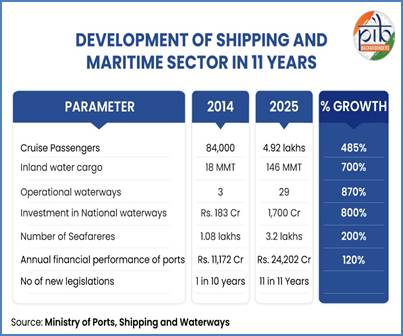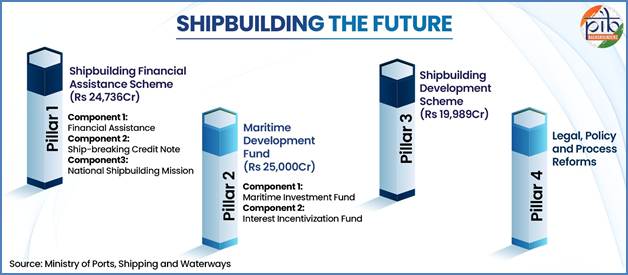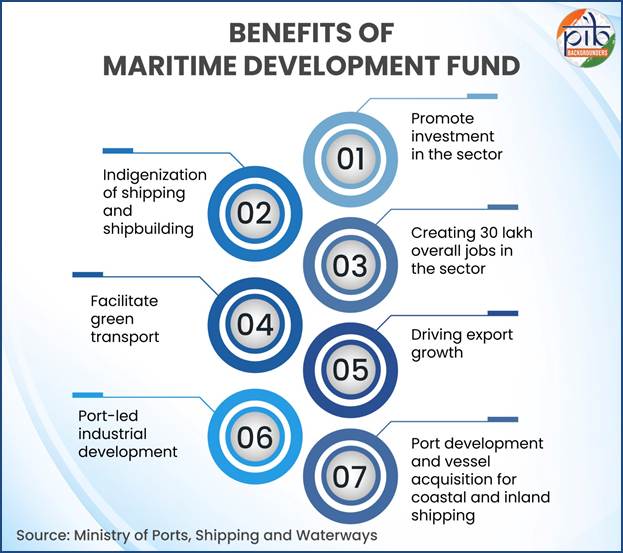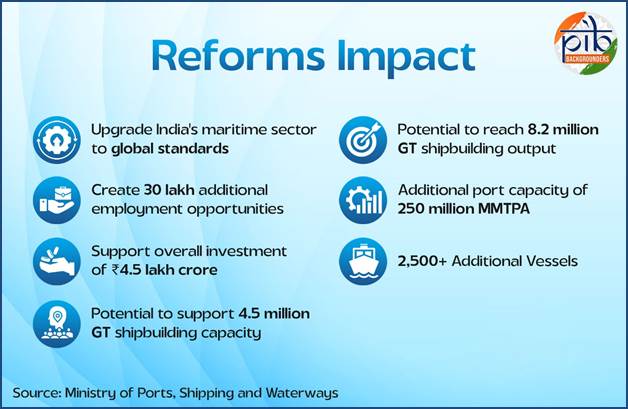Setting Sail India’s Shipbuilding Revival
Setting Sail India’s Shipbuilding Revival
Key Takeaways
Overview
Anchored in tradition and powered by technology, India’s shipbuilding landscape is poised for global recognition. India’s maritime sector has historically served as a vital link connecting the subcontinent to global trade routes, with centuries of seafaring and commerce shaping its economic foundation. India’s shipbuilding tradition dates back to the Indus Valley Civilization, with archaeological evidence from sites like Lothal (in present-day Gujarat) indicating the existence of dockyards and maritime trade. Lothal’s dock is considered one of the world’s earliest known tidal docks.
Shipbuilding, often termed the “mother of heavy engineering”, plays a central role by generating employment, attracting investment, and strengthening national security and strategic independence. India’s shipbuilding sector creates strong economic impact; each investment boosts jobs 6.4 times and returns 1.8 times the capital, showing its power to drive growth and development. This industry holds significant promise for creating large-scale employment opportunities in remote, coastal, and rural regions. Its development and promotion are being prioritized as a key driver in advancing the vision of an Atmanirbhar Bharat.
Shipbuilding Sector Growth & Development
Post-independence, shipbuilding was largely concentrated in public sector units like Mazagon Dock Shipbuilders Ltd (Mumbai), Garden Reach Shipbuilders & Engineers Ltd (Kolkata), and Hindustan Shipyard Ltd (Visakhapatnam). Over the past decade, with entry of private ship players in the sector, India’s shipping and maritime sector has witnessed remarkable transformation, with significant strides in cruise tourism, inland water transport, and port infrastructure. Strategic investments, policy reforms and expanded waterways have collectively boosted cargo movement, coastal connectivity

and employment opportunities positioning the sector as a key driver of economic growth and regional integration. As of November 2024, India has a fleet of 1,552 Indian-flagged vessels, totalling 13.65 million Gross Tonnage (GT).
KEY GOVERNMENT POLICIES & INITIATIVES
Shipbuilding Sector Revitalization
Recent government announcements in September, 2025 for the shipbuilding sector focus on expanding domestic capacity, improving access to long-term financing, and creating a globally competitive ecosystem. These measures aim to generate large-scale employment, attract investment, and strengthen India’s strategic and economic resilience through modern infrastructure and policy reforms.

Component 1: Financial Assistance
Component 2: Ship-breaking Credit Note
Component 3: National Shipbuilding Mission
Component 1: Maritime Investment Fund
Component 2: Interest Incentivization Fund

Shipbuilding Development Scheme
Legal, Policy and Process Reforms

Conclusion:
India’s shipbuilding sector is entering a promising phase of growth, supported by a series of progressive initiatives and policy reforms. These measures aim to modernize infrastructure, enhance domestic manufacturing capabilities, and attract global investment, laying a strong foundation for long-term development. By focusing on innovation, sustainability, and skill development, the sector is well-positioned to meet the strategic goals outlined in Maritime India Vision 2030. Furthermore, its expansion aligns seamlessly with the broader national aspiration of Viksit Bharat 2047, contributing to economic resilience, employment generation, and global competitiveness. With continued collaboration between industry and government, India’s shipbuilding industry is set to become a key pillar of the country’s maritime strength and a driver of inclusive growth.
References:
Press Information Bureau:
https://www.pib.gov.in/Pressreleaseshare.aspx?PRID=2035583
https://www.pib.gov.in/PressReleasePage.aspx?PRID=2168994
https://www.pib.gov.in/PressReleaseIframePage.aspx?PRID=2085228
https://www.pib.gov.in/PressReleasePage.aspx?PRID=2110319
https://www.pib.gov.in/PressReleseDetailm.aspx?PRID=2172488
https://www.pib.gov.in/PressReleasePage.aspx?PRID=2170575
- Shipbuilding Financial Assistance Policy (SBFAP): Offers 20–30% financial assistance for vessels using green fuels or hybrid propulsion systems.